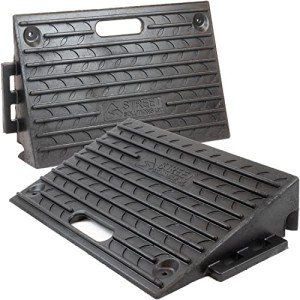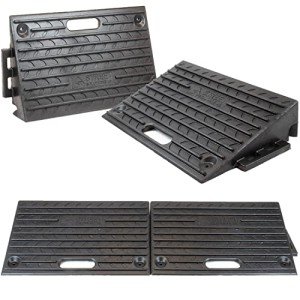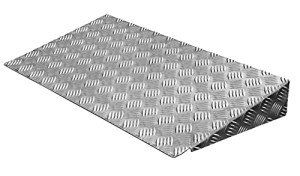In a world increasingly focused on accessibility and inclusivity, having the right mobility aids is crucial for individuals who rely on wheelchairs. Among the most significant challenges faced by wheelchair users are steps and curbs. Portable anti-slip wheelchair ramps provide a practical solution to overcome these obstacles, offering a safe and efficient way to navigate various terrains. This guide delves into the advantages, features, and considerations for choosing the right portable anti-slip wheelchair ramp for steps.
Understanding Portable Anti-Slip Wheelchair Ramps
What are Portable Anti-Slip Wheelchair Ramps?
Portable anti-slip wheelchair ramps are designed specifically to assist individuals using wheelchairs or mobility scooters in overcoming elevation changes such as steps, curbs, and uneven surfaces. These ramps are lightweight, easy to transport, and can be set up quickly, making them ideal for home use, public spaces, or during travel.
Importance of Non-Slip Features
The non-slip surface of these ramps is vital for ensuring the safety of users. When navigating an incline, especially in wet or icy conditions, the risk of slipping increases. Anti-slip features, such as textured surfaces, rubber grips, or raised edges, help prevent accidents and provide peace of mind for users and caregivers alike.
Key Advantages of Portable Anti-Slip Wheelchair Ramps
-
Simplicity and Ease of Use
Portable ramps are lightweight and can often be set up by a single person in a matter of minutes. Their ease of use makes them accessible for individuals with limited mobility, allowing them to gain independence when navigating different environments. -
Versatile Applications
These ramps can be used in multiple settings, including homes, public transportation, outdoor events, and more. They serve various purposes, from accessing porches and steps to loading vehicles and entering buildings. -
Foldable and Compact
Most portable ramps can be folded in half or into a compact size, making them easy to store in a vehicle trunk, closet, or storage space. This feature is particularly valuable for people who may need to transport the ramp frequently. -
Customization for Various Needs
Portable anti-slip ramps come in different lengths, widths, and load capacities. Many models can accommodate different wheelchair types and sizes, meeting the diverse requirements of users. -
Enhanced Safety Features
Apart from the anti-slip surface, many ramps are equipped with additional safety features such as side curbs or tapered edges to prevent wheels from slipping off, offering an added layer of security for the user.
Choosing the Right Portable Anti-Slip Wheelchair Ramp
Considerations Before Purchase
When selecting a portable ramp, there are several factors to consider to ensure the selected ramp meets the user's needs:
-
Length and Height: The length of the ramp should be appropriate for the height of the steps or curb it will be used for. As a general rule, a slope ratio of 1:12 is recommended for wheelchairs—meaning for every inch of height, you need 12 inches of ramp length.
-
Weight Capacity: Always check the weight limit of the ramp to ensure it can safely support both the wheelchair and the individual using it.
-
Material: Ramps are commonly made from aluminum, fiberglass, or plastic. Aluminum ramps tend to be lightweight yet durable, while fiberglass ramps offer added stability and can withstand more weight.
-
Portability Features: Look for ramps that are foldable, lightweight, and equipped with carrying handles or straps for easier transportation.
-
Surface Type: Opt for ramps with a designated anti-slip surface, as well as consider how well the surface performs in various weather conditions.
FAQs about Portable Anti-Slip Wheelchair Ramps
1. How do I measure the height for a ramp?
To measure the height for a ramp, use a tape measure to determine the vertical distance from the ground to the top of the step or curb. This measurement will help you select an appropriately sized ramp.
2. Are temporary ramps suitable for outdoor use?
Yes, many portable ramps are designed for both indoor and outdoor use. However, it is essential to verify the ramp's material and weather resistance to ensure its durability in outdoor conditions.
3. Can I use a ramp with a power wheelchair or scooter?
Absolutely! Portable ramps are designed to accommodate various types of wheelchairs, including manual and power models, as well as mobility scooters.
4. How do I maintain my portable ramp?
Keep it clean by wiping it down with a damp cloth to remove dirt and debris. Periodically inspect for wear and tear, and avoid storing it in extreme temperatures to prolong its life.
5. Can a helper assist in using the ramp?
Yes, having a caregiver or friend to assist when using the ramp can provide additional safety and support, especially when navigating steeper inclines or uneven surfaces.
Portable anti-slip wheelchair ramps are essential tools for promoting mobility and independence among individuals with disabilities. By combining safety features with versatility and ease of use, they serve as invaluable aids for those who need to navigate steps and curbs in their day-to-day lives. When choosing a suitable ramp, it's essential to consider length, width, weight capacity, and material to ensure the perfect match for the user’s needs. Investing in a high-quality portable anti-slip wheelchair ramp ultimately provides greater access to the world beyond stairs and thresholds, fostering a more inclusive environment.







